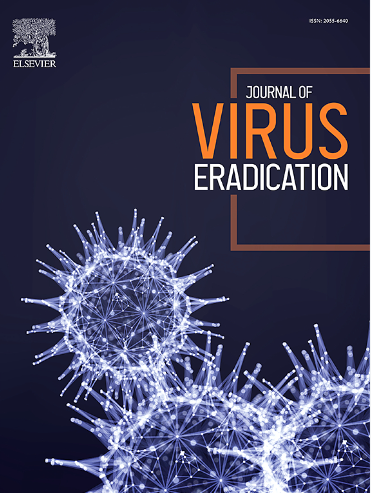2023年埃塞俄比亚西北部贡达尔市24-36个月儿童第二剂含麻疹疫苗接种的及时性及其决定因素:基于社区的横断面研究设计
IF 2
4区 医学
Q2 IMMUNOLOGY
引用次数: 0
摘要
尽管有有效的疫苗,但麻疹仍然是一个全球公共卫生问题。最近的疫情突出了强有力的疫苗接种规划的必要性。自推出这两种剂量以来,埃塞俄比亚一直在与全球卫生组织合作,以增加疫苗接种的覆盖率。然而,仅仅关注覆盖率忽略了及时接种疫苗的重要性。在埃塞俄比亚,尽管覆盖率偶尔有所增加,但由于对及时性的重视不够,麻疹疫情持续存在。本研究旨在评估贡达尔市第二剂含麻疹疫苗接种的及时性及其决定因素,为加强免疫规划和预防麻疹感染提供信息。方法对618例24 ~ 36月龄儿童进行社区横断面研究。从4月25日到5月25日,采用两阶段系统随机抽样的方法选择参与者。通过访谈进行结构化问卷调查,使用Kobo工具箱收集数据,然后使用Stata version 17进行分析。采用二元逻辑回归模型确定与结果相关的因素,p值为<;0.05。采用95%置信区间的校正优势比来评估关联的方向和强度。结果618例儿童中,523例(84.63%)(95% CI: 81.77% ~ 87.48%)及时(在国家推荐年龄)接种了MCV2疫苗。父亲大专及以上学历(AOR: 5.84, 95% CI: 1.55-8.18)、四次及以上ANC随访(AOR: 5.84, 95% CI: 1.55-8.18)、至少两次维生素a摄入(AOR: 6.39, 95% CI: 2.92-12.59)、母亲对麻疹疫苗的认知度高(AOR: 2.04, 95% CI: 1.05-3.99)、母亲对麻疹疫苗的认知度高(AOR: 4.81, 95% CI: 2.13-10.86)是及时接种第二剂麻疹疫苗的重要决定因素。结论与建议研究区麻疹第二剂疫苗的及时接种率不理想,应继续努力根除麻疹感染。父亲的受教育程度、ANC随访、维生素a的重复摄取、母亲的意识和对麻疹疫苗接种的认识是及时接种第二剂麻疹疫苗的统计学显著决定因素。加强妇幼保健服务,提高认识,并改变母亲对麻疹疫苗接种的看法,可能会增加接受第二剂MCV的儿童及时接种MCV2。本文章由计算机程序翻译,如有差异,请以英文原文为准。
Timeliness of the second dose of measles-containing vaccine uptake and its determinants among children aged 24–36 months in Gondar City, Northwest Ethiopia, 2023: Community-based cross-sectional study design
Background
Measles remains a global public health concern, despite the availability of effective vaccines. Recent outbreaks highlight the need for strong vaccination programs. Since launching both doses, Ethiopia has been working with global health organizations to increase vaccination coverage. However, focusing solely on coverage overlooks the importance of timely vaccination. In Ethiopia, despite occasional increases in coverage, measles outbreaks persist due to insufficient attention to timeliness. This study aims to assess the timeliness and its determinants of second-dose measles-containing vaccine uptake in Gondar City to inform efforts to strengthen immunization programs and prevent measles infections.
Methods
A community-based cross-sectional study was conducted among 618 children aged 24–36 months. Participants were selected using a two-stage systematic random sampling method from April 25 to May 25. Structured questionnaires were administered through interviews, and data were collected using the Kobo toolbox and then analyzed using Stata version 17. A binary logistic regression model was utilized to determine factors associated with the outcome, with significance declared at a p-value <0.05. Adjusted odds ratios with 95 % confidence intervals were used to assess the direction and strength of associations.
Results
Among the total of 618 children, 523 (84.63 %) (95 % CI: 81.77 %–87.48 %) were vaccinated for MCV2 timely (in the national recommended age). Paternal college and above in their education (AOR: 5.84, 95 % CI: 1.55–8.18), four or more ANC follow-ups (AOR: 5.84, 95 % CI: 1.55–8.18), at least two doses of vitamin An uptake (AOR: 6.39, 95 % CI: 2.92–12.59), mothers having high awareness (AOR: 2.04, 95 % CI: 1.05–3.99), and mothers having positive perception (AOR: 4.81, 95 % CI: 2.13–10.86) to measles vaccination were significant determinants for timely uptake of the second dose measles-containing vaccine.
Conclusion and recommendations
The timely uptake of the second dose of the measles vaccine in the study area was suboptimal, and efforts should be continued to eradicate measles infection. Paternal educational status, ANC follow-ups, repeated vitamin An uptake, maternal awareness, and perception of measles vaccination were statistically significant determinants for the timely uptake of a second dose of measles-containing vaccine. Strengthening maternal and child health services, increasing awareness, and changing mothers' perceptions about measles vaccination may increase the timely uptake of MCV2 among children receiving a second MCV dose.
求助全文
通过发布文献求助,成功后即可免费获取论文全文。
去求助
来源期刊

Journal of Virus Eradication
Medicine-Public Health, Environmental and Occupational Health
CiteScore
6.10
自引率
1.80%
发文量
28
审稿时长
39 weeks
期刊介绍:
The Journal of Virus Eradication aims to provide a specialist, open-access forum to publish work in the rapidly developing field of virus eradication. The Journal covers all human viruses, in the context of new therapeutic strategies, as well as societal eradication of viral infections with preventive interventions.
The Journal is aimed at the international community involved in the prevention and management of viral infections. It provides an academic forum for the publication of original research into viral reservoirs, viral persistence and virus eradication and ultimately development of cures.
The Journal not only publishes original research, but provides an opportunity for opinions, reviews, case studies and comments on the published literature. It focusses on evidence-based medicine as the major thrust in the successful management of viral infections.The Journal encompasses virological, immunological, epidemiological, modelling, pharmacological, pre-clinical and in vitro, as well as clinical, data including but not limited to drugs, immunotherapy and gene therapy. It is an important source of information on the development of vaccine programs and preventative measures aimed at virus eradication.
 求助内容:
求助内容: 应助结果提醒方式:
应助结果提醒方式:


